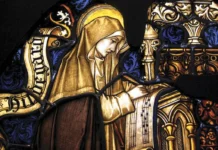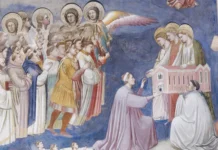Could the growing interest in the consecration to Jesus through Mary proposed by St. Louis Marie Grignion de Montfort be a sign that the Reign of Mary is drawing near?

Discovered in the mid-nineteenth century after being hidden for over a century, the work True Devotion to Mary has, since that time, spread throughout the world. The cornerstone of the spirituality of many modern Saints, it was praised by Popes of the past century and has become the bedside book of innumerable devotees of the Virgin Mother.
What does this work teach us? It invites us to consecrate ourselves to Our Lady as slaves of love, so as to belong more perfectly to Our Lord Jesus Christ. And it does this combining a passionate and unpretentious language with the most profound theological arguments.
But True Devotion is also, and perhaps principally, a prophetic work. It foretells the glorious triumph of the Virgin Mother and the foundation of a historical era which we could call the Reign of Mary, and it foresees the emergence of souls filled with the spirit of Mary Most Holy, of whom she will serve to restore faith, charity and true love to the Holy Church.
What have the Popes said?
The salvific efficacy of the devotion taught by St. Louis Marie Grignion de Montfort was acknowledged, at the dawn of the twentieth century, by Pope Leo XIII, who beatified its author and granted a plenary indulgence to all those who make or renew this consecration to Jesus through Mary on December 8, feast of the Immaculate Conception, and April 28, feast of St. Louis de Montfort.
St. Pius X also greatly esteemed True Devotion and twice confided having been inspired by it to write the Marian Encyclical Ad diem illum. 1 On December 27, 1908, he granted “with his whole heart and lively affection, an apostolic blessing to all those who read the True Devotion, so admirably written by Blessed Montfort.” 2
In a letter to the Superior General of the Company of Mary, on the occasion of the centenary of St. Louis de Montfort’s death, Benedict XV “made a special commendation of the little book of true devotion, due to its ‘mellifluous unction and rock solid doctrine.’” 3
Pius XI, by means of his Secretary of State, Cardinal Pacelli, the future Pius XII, praised the German edition of the Treatise of True Devotion and other works of its holy author.
At the beginning of his discourse on the then Blessed Louis de Montfort, in granting the decree for his canonization, Pius XII compared him to the “great Father and Doctor, St. Bernard of Clairvaux.” 4
St. John Paul II went even further: he consecrated himself to Our Lady as a slave according to the method of St. Louis Grignion de Montfort. He extolled True Devotion on several occasions and made special mention of its author, in treating of authentic Marian spirituality, in the Encyclical Redemptoris Mater: “In this regard, I would like to recall, among the many witnesses and teachers of this spirituality, the figure of St. Louis Marie Grignion de Montfort, who proposes consecration to Christ through the hands of Mary, as an effective means for Christians to live faithfully their baptismal commitments.” 5
Christ will reign in the world by means of Mary
True Devotion to Mary shows us, as has already been said, the supreme importance of Mary Most Holy in the work of creation, her fight against the devil and her prophetic role, especially in the historic period which St. Louis calls the latter times.
The holy author closes the Introduction of his work explaining that “Mary has been unknown up till now,” and therefore Our Lord Jesus Christ “is not known as He should be.” 6 And he concludes affirming that the knowledge and the Reign of Jesus will only come to the world “as a necessary consequence of the knowledge and reign of Mary,” 7 for, just as she brought Him into the world the first time, it befits her to make Him shine in His second coming. A daring affirmation, difficult to find in other authors…
According to the logic of True Devotion, its purpose is to spread devotion to Our Lady so that the Reign of Christ will come. “Therefore, it is a work of broad vision and of comprehensive historical scope, focusing on the desire to bring the Reign of Christ to a world lacking it, in such a way that it is preceded, in a certain sense, by the reign of Mary Most Holy.” 8
St. Louis Marie exposes his theological foundation in the opening words of True Devotion: “It was through the Blessed Virgin Mary that Jesus Christ came into the world, and it is also through her that He must reign in the world.” 9 Now, if the Reign of Christ must come to the world through Our Lady, then spreading devotion to her with this in view is “the greatest work to which anyone can aspire.” 10
Therefore, the devotion taught by this great Saint is of capital importance for the establishment of the Reign of Christ. This is another point not easily found in the manuals of Mariology.
She is the earthly paradise of the New Adam
Still in the Introduction, the Saint expounds on his praises to the most august Queen of Heaven. “I declare with the Saints: Mary is the earthly paradise of Jesus Christ the New Adam, where He became man by the power of the Holy Spirit, in order to accomplish in her wonders beyond our understanding.” 11 She is the great and divine world of God, the magnificence of the Most High, where He hid His only Son and “with Him everything that is most excellent and precious.” 12

After noting that worldly spirits do not know the grandeurs of the Virgin Mary because they are unworthy and incapable of knowing them, Grignion de Montfort highlights a truth somewhat relegated to oblivion in our days: “The Saints have said wonderful things of Mary, the holy City of God, and, as they themselves admit, they were never more eloquent and more pleased than when they spoke of her.” 13
In fact, one universal characteristic of all the Saints is a very special and intense devotion to Our Lady. Further on, St. Louis Grignion demonstrates how this devotion is necessary to all the baptized, a requirement of any authentic spiritual life.
The role of Our Lady in the Incarnation
But he does not stop here. Delving deeper into the theological reasons for devotion to the Blessed Virgin, he treats of a subject of greatest transcendence: the Most High wished to make use of Mary in the Incarnation; and he sustains that this devotion is based on the central role she played in this fundamental event.
Indeed, the Incarnation of the Word is the culminating episode of human history; nothing in the field of human events that can even come close to the importance of this most sublime fact: “The Word became flesh and dwelt among us” (Jn 1:14). As a consequence, in the divine plan for creation and Redemption, the Mother of God has the most important and fundamental role.
Given this unsurpassed position of the Virgin Mary, St. Louis de Montfort draws lofty considerations on her relationship with the three Persons of the Blessed Trinity.
Relationship with the Blessed Trinity
The Eternal Father communicated to her His fecundity so that she could give birth to His Divine Son and to all the members of the Mystical Body of Christ. Accordingly, Mary is the Mother of all the faithful in the order of grace.
Our Lady’s cooperation with God the Son is seen in the fact that she formed His most holy Body, nourished Him and cared for Him in His infancy. She was a living tabernacle, in which Jesus Christ began to glorify the Father on this earth, from the first moment of the hypostatic union.
As for her collaboration with the Holy Spirit, Mary being truly the Spouse of the Holy Spirit, the sublimity and intimacy of her participation in this event is impossible to imagine. It is for her, in this situation, to exercise a most important role in the sanctification and perseverance of the faithful.
Continuing in his solid argumentation, Grignion de Montfort demonstrates in a brilliant fashion that Our Lord Jesus Christ is the ultimate end of devotion to Mary. This point is fundamental, for it dismantles the sophisms of all those who object to devotion to Our Lady, under the fallacious pretext that it may be a hindrance to devotion to our Divine Redeemer.
Slavery to Mary and its consequences
The essential point of the “true devotion” preached by St. Louis Grignion is the consecration as a slave of love to the Most Holy Virgin. He rightly emphasizes in True Devotion that this consecration is in fact a consecration to Our Lord Jesus Christ “through the hands of Mary,” an expression repeated numerous times in his portentous work.
Some readers may be taken aback with St. Louis’ use of the word slave, adapted from St. Paul (cf. Phil 2:7) to designate a total surrender to Jesus Christ by means of His Most Holy Mother. Nevertheless, the Saint explains, this is a perfect renewal of the baptismal promises, which every Catholic makes a number of times throughout his life.
Before Baptism, St. Louis explains, every human being is a slave of the devil, and belongs to him. However, at the time of Baptism, a person solemnly renounces satan, his pomps and works, and takes Jesus Christ for His Master and sovereign Lord, becoming His slave of love. And he concludes: “This is what is done in the devotion I am presenting to you. We renounce the devil, the world, sin and self, as expressed in the act of consecration, and we give ourselves entirely to Jesus through Mary.” 14 But with an important difference: in Baptism, children express themselves through the voice of their godparents; in this devotion, one speaks for himself, in a fully informed choice.

She never lets herself be outdone in love
Grignion de Montfort goes on to present several reasons that should encourage us to practice true devotion to Our Lady. By it, one consecrates oneself entirely to the service of God, without compromising their duties of state; it leads us to imitate the example of Jesus Christ and to practice the virtue of humility.
In the third reason, the author emphasizes how we benefit from this devotion. The Most Holy Virgin, he explains, never lets herself be outdone in love and generosity. Seeing a person consecrate himself entirely to her, to honour and to serve her, “she gives herself completely in a wondrous manner to him. She engulfs him in the ocean of her graces, adorns him with her merits, supports him with her power, enlightens him with her light, and fills him with her love. She shares her virtues with him − her humility, faith, purity, etc. She makes up for his failings and becomes his representative with Jesus.” 15
This alone is sufficient to show that the graces and benefits we accrue from the practice of this devotion are unfathomable. However, there is much more.
Given the incomparable relationship of the Virgin of virgins with the Blessed Trinity, those who give themselves entirely to her as a slaves of love gain a much richer, more intense and intimate relationship with this same Trinity; their relationship with the Holy Eucharist also changes, for they begin to receive Communion with Mary, in Mary, by Mary and for Mary. In effect, those who consecrate themselves to Mary enter into a new economy of grace.
In sum, the attitude of this faithful Virgin toward her children and slaves is utterly ineffable. “She loves them: Because she is truly their Mother. What mother does not love her child, the fruit of her womb? She loves them in gratitude for the active love they show to her, their beloved Mother. She loves them because they are loved by God […]; She loves them because they have consecrated themselves entirely to her and belong to her portion, her inheritance.” 16 Furthermore: if they are faithful in the practice of this devotion, the soul of the Blessed Virgin will be communicated to each one of them to glorify the Lord; her spirit will take the place of theirs to rejoice in God our Saviour. 17
The devil’s hatred for “True Devotion”
We could easily include here long passages from this marvellous book, but we prefer to invite readers to personally peruse its pages and let themselves be guided by this exemplary devotee of Mary Most Holy.
St. Louis Marie Grignion de Montfort was a Saint gifted with a prophetic charism, which can be detected in various passages of True Devotion and, even more so, in his supplication entitled Fiery Prayer. Reading it, one seems to feel the sacred fire that burned in the soul of this apostle.
In one such passage, he declares to clearly foresee that frightful beasts will appear and in their fury try to tear to pieces with their diabolical teeth “this little book and the one the Holy Spirit made use of to write it,” 18 or, at least, to hide it in the bottom of some chest where no one will find it. Was he discouraged at such a perspective? Not at all! This prevision inspired in him the hope of great success, namely, the emergence of “a mighty legion of valiant soldiers of Jesus and Mary, both men and women, who will fight the devil, the world, and corrupt human nature in the perilous times that are sure to come.” 19
The first part of this prophecy was fulfilled to the letter. St. Louis departed for Heaven in 1716, some years after having written this book. However, for various motives, including the need to hide the precious manuscripts during the period of persecutions against the Church incited by the French Revolution, the first edition was made available to the public only in 1843. This signified a wait of almost one hundred and thirty years.
Mary and the apostles of the latter times
The great Marian Saint also speaks in a prophetic tenor as he makes reference to “these latter times,” 20 in which God wishes to reveal the masterpiece of creation to the whole world.
“In these latter times Mary must shine forth more than even in mercy, power and grace.” 21 In mercy, he explains, to lovingly receive the poor sinners who will convert; in power, against the hardened enemies of God and the Church; in grace, to encourage and sustain the courageous and faithful servants who will fight for the interests of Jesus Christ.
And he concludes with this affirmation: “Lastly, Mary must become as terrible as an army in battle array to the devil and his followers, especially in these latter times. For satan, knowing that he has little time − even less now than ever − to destroy souls, intensifies his efforts and his onslaughts every day. He will not hesitate to stir up savage persecutions and set treacherous snares for Mary’s faithful servants and children whom he finds more difficult to overcome than others.” 22
But who will be “Mary’s faithful servants and children”? In an ardent prophecy of love to Our Lady, St. Louis draws their spiritual profile: “They will be ministers of the Lord who, liking a flaming fire, will enkindle everywhere the fires of divine love. They will become, in Mary’s powerful hands, like sharp arrows, with which she will transfix her enemies.” 23
“Thoroughly purified by the fire of great tribulations,” the Saint continues, these slaves of the Virgin “will carry the gold of love in their heart, the frankincense of prayer in their mind and the myrrh of mortification in their body.” 24 Like “thunder-clouds flying through the air at the slightest breath of the Holy Spirit,” 25 they will shower down the rain of God’s word, thunder against sin, storm against the world and smite the devil and his followers.
In short, “they will be true apostles of the latter times to whom the Lord of Hosts will give eloquence and strength to work wonders and carry off glorious spoils from his enemies.” 26 They “will have the two-edged sword of the Word of God in their mouths and the blood-stained standard of the Cross on their shoulders. The will carry the crucifix in their right hand and the rosary in their left, and the holy names of Jesus and Mary on their heart.” 27
But when and how will this happen? The way and the hour, only God knows, but St. Louis offers wise advice: “For our part we must yearn and wait for it in silence and in prayer.” 28

A prophetic hope
In his great work, St. Louis Grignion de Montfort expresses the hope that the Queen of Heaven herself will obtain from her Divine Spouse that He lead a chosen man to the highest degree of the true devotion he proclaimed.
As the essential aspect of this devotion, the Saint explains, consists in the interior that it must form, it will not be understood equally by all. Some, the greater number, will limit themselves to its exterior aspect. Far fewer will be those who enter into its interior, ascending but one step. Fewer still will be those who ascend a few steps higher.
Finally, the Saint asks himself, who will completely identify with it? And he responds: “Only the one to whom the Spirit of Jesus reveals the secret. The Holy Spirit Himself will lead this faithful soul from strength to strength, from grace to grace, from light to light, until at length he attains transformation into Jesus in the fullness of His age on earth and His glory in Heaven.” 29
As we pointed out at the beginning of these lines, the number is daily increasing of those who wish to consecrate themselves to the Most Holy Virgin according to the method of St. Louis Grignion. They include men and women, especially young people, from every profession and social category. In some countries, online preparation courses are even offered for this consecration.
Is not the growing interest to practise this special form of devotion to the Virgin Mother of God, and through her to Our Lord Jesus Christ, a sign that we are living in promising days and can already glimpse on the horizon the emergence of the Reign of Mary he prophesied? ◊
St. Louis Marie Grignion de Montfort

St. Louis Marie Grignion de Montfort was born in 1673 in the small Breton city of Montfort-la-Cane, presently Montfort-sur-Meu, France. The second of eighteen children of a deeply Catholic family, he completed his secondary schooling at the Jesuit college of Rennes. Since childhood, he felt drawn to the priesthood, and his vocation was confirmed one day while he prayed before a statue of Our Lady of Peace. He clearly heard an interior voice say: “You will be a priest.”
At twenty, he entered the famous St. Sulpice Seminary of Paris, perhaps the most important of France at that time. He flourished under the influence of the French School of Spirituality, formed by true men of God, such as Cardinal Pierre de Bérulle, Fr. Jean-Jacques Olier, St. John Eudes and others. Initially, a great devotion to the Holy Eucharist and the Blessed Virgin predominated there.
As he did not have the means to finance his tuition, his superiors put the young seminarian to work in the seminary library. This was to be providential, for he was thereby introduced to the works of the principal theologians, Fathers of the Church and many other Saints who enlightened the Christian world with their doctrine. Without compromising his theological studies, he set about putting together a collection of commentaries from all these authors with regard to the Mother of God.
Unfortunately, this seminary had distanced itself from the good influences of the past and was infected by the Jansenist heresy which, among other evils, stifled piety, devotion to the Eucharist and to the Blessed Virgin. As a result, St. Louis became the object of contempt and persecution in that setting.
Ordained priest in 1700, at twenty-seven years of age, he launched himself with ardour into the work of evangelization, but the Jansenists raised so many obstacles and objections against him that he decided to journey to Rome with the goal of requesting Pope Clement XI to send him to Canada as a missionary. The Vicar of Christ gave him the title of apostolic missionary and commanded him to continue his apostolate in France.
Accordingly, he returned to France, but, far from ceasing, the persecutions only increased to such a point that he was eventually restricted to preaching in just two dioceses: Luçon and La Rochelle.
With the premonition that the end of his short life was approaching – he died at the age of forty-three –, he withdrew to a grotto on the outskirts of La Rochelle, seeking tranquillity. There he composed the True Devotion to Mary, writing “rapidly, full of enthusiasm and as if impelled by divine inspiration” (PÉREZ, SJ, Nazario. Introducción. In: ST. LOUIS MARIE GRIGNION DE MONTFORT. Obras. Madrid: BAC, 1954, p.425).







